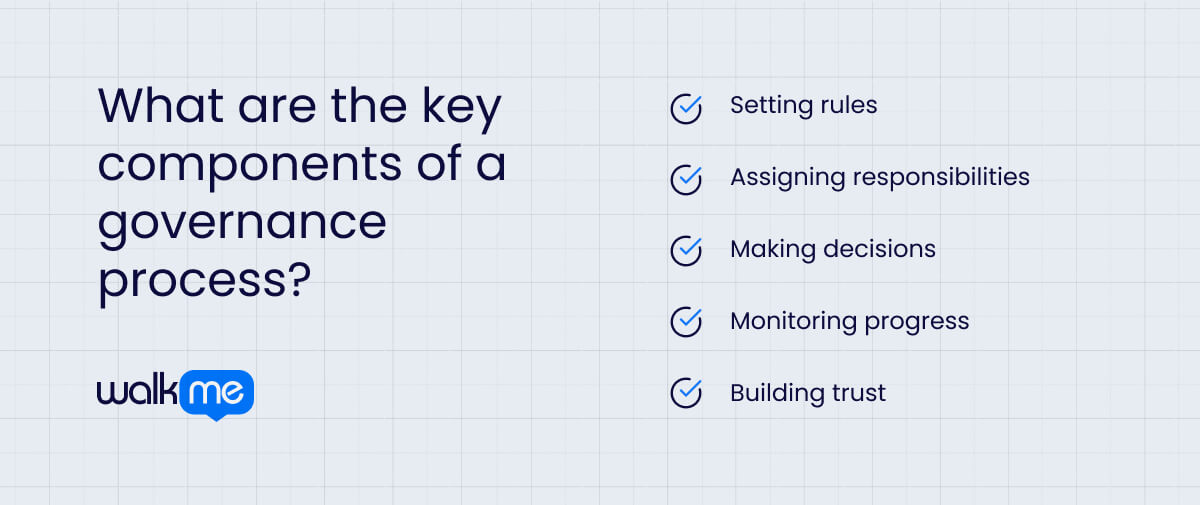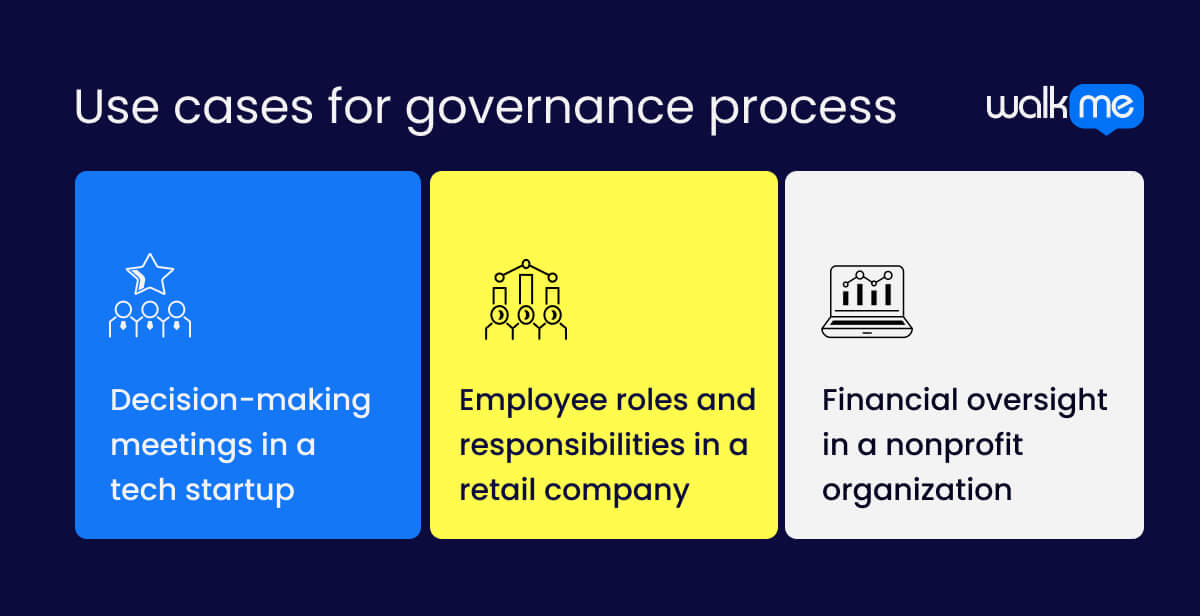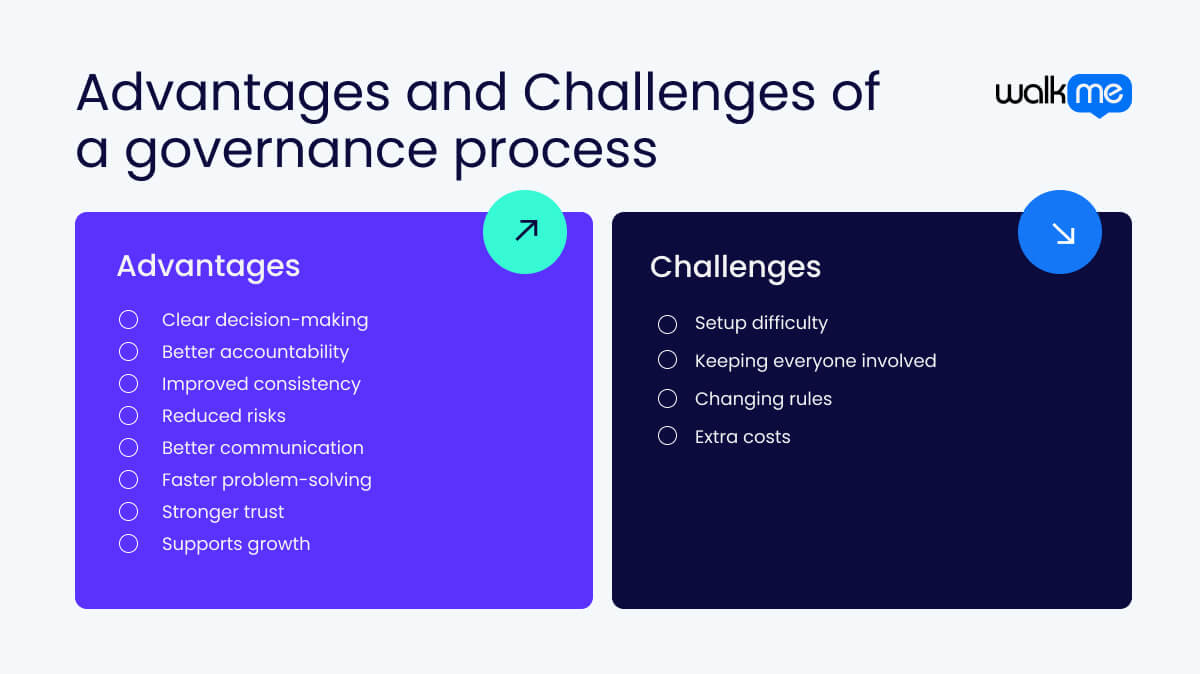What is a governance process?
The governance process ensures that organizations work well and achieve their goals. It helps them create a plan for making decisions, following rules, and sharing responsibilities.

Governance helps organizations stay organized and ensures that people are doing the right things. It involves setting rules so everyone knows what is expected. It also means making sure the right people are in charge of the right tasks, which helps things get done correctly. By having a clear process, organizations can solve problems and make good choices that help them reach their goals.
A good governance process also makes sure the organization is transparent, meaning everyone can see how decisions are made. It helps keep the organization safe from mistakes and problems, and it builds trust with employees, customers, and other important people. It helps the organization stay on track and continue to grow in a healthy way.
The governance process helps organizations stay strong and adapt to changes. It includes a board of directors who guide the organization and make sure it follows important values and goals. For example, Norway’s sovereign wealth fund, NBIM, uses governance to make sure companies are open and act responsibly.
A study from FCLTGlobal and McKinsey shows that leaders and board members can stay focused on long-term goals by acting in certain ways. The research says it’s important for leaders to have a clear plan for the future and make decisions that help the organization grow over time. By thinking ahead and not giving in to short-term pressures, leaders can help their companies stay strong and successful in the long run.
What are the key components of a governance process?

Understanding the key components of the governance process is important for understanding how an organization stays organized and works smoothly. These components help ensure decisions are made, tasks are completed, and everyone knows their role. Together, they keep the organization on track and help it reach its goals.
Let’s explore the key parts that make up a strong governance process.
Setting rules
Rules help guide how the organization should operate. They ensure everyone knows what is expected of them and how to act in different situations. When people follow the rules, confusion is avoided, and everything runs smoothly. Without clear rules, the organization might face problems or misunderstandings. By sticking to the rules, everyone in the organization can stay focused on their work and contribute to its success.
Assigning responsibilities
In a well-governed organization, each person is given a clear role or task to handle. Everyone knows what they are responsible for and tasks are less likely to be missed or duplicated. When people understand their responsibilities, it helps things get done faster and more efficiently. With clear roles, the organization can function better because everyone works together toward a common goal. When each person does their part, it leads to a more organized and effective team.
Making decisions
Decision-making is an important part of the governance process. Leaders and teams must make choices that solve problems, keep things on track, and help the organization move forward. Making good decisions ensures that the organization is heading in the right direction. These decisions may involve changing strategies, solving problems, or planning for the future. Clear decision-making helps everyone stay focused on the goals and contributes to the overall success of the organization.
Monitoring progress
Regularly checking how things are going is important for staying on track. By monitoring progress, the organization can see if things are working well or if changes are needed. If there are problems, the organization can make adjustments to fix them and continue working toward its goals. Monitoring ensures that the plan is being followed and that any challenges are addressed quickly. Without monitoring, it would be hard to know if things are going as planned or if improvements are needed.
Building trust
A strong governance process helps build trust between the organization and its people, like employees, customers, and partners. When everyone knows the rules and their responsibilities, it creates a sense of fairness and confidence. Trust is important because it makes people feel safe and valued, and it encourages them to do their best work. When trust is built through good governance, it leads to stronger relationships and a more successful organization. Trust helps people work together toward shared goals and improves the overall working environment.
Governance process vs. governance framework vs. process management
The governance process, governance framework, and process management are all about how an organization works, but they focus on different things.
- The governance process is about making decisions and setting rules
- The governance framework gives the guidelines for how decisions should be made
- Process management focuses on improving how tasks and work are done to make everything run smoothly.
Let’s look at the differences between these terms in more detail.
| Governance process | Governance framework | Process management | |
| Definition | A way to make decisions, set rules, and make sure people follow them in an organization. It shows how things should be done. | A set of rules and guidelines that explain how the governance process should work. It helps guide decisions and actions. | A way of managing how work gets done in an organization. It looks at how tasks are done and tries to make them faster and better. |
| Focus | How decisions are made and who is in charge of what in the organization. | The guidelines and rules that guide the governance process. | Improving the steps or tasks that are done in the organization to make them more efficient. |
| Techniques | Making clear rules, assigning responsibilities, and checking to make sure the rules are followed. | Rules, standards, and practices that guide how the governance process should work. | Looking at how work is done, finding ways to improve it, and making sure it’s efficient. |
| Goals | Make sure the organization is making the right decisions and staying on track with its rules and responsibilities. | Set up clear rules and principles for how decisions should be made in the organization. | Improve how tasks and work are done, making them faster, better, and more effective. |
| Examples of use | A company might use the governance process to decide how to spend money, who makes important decisions, and how to stay organized. | A business might have a framework that explains how to follow the law, stay ethical, and make sure everyone is treated fairly. | A business might use process management to improve customer service, like making sure customers get answers faster or solving problems more easily. |
Use cases for governance process

The governance process shows up in different ways across businesses. Whether it’s helping a startup make decisions, making sure employees know their roles in a retail store, or tracking money in a nonprofit, it’s important to keep things organized.
It can be difficult to see how the governance process works in real life, so here are three examples to show how it applies to different businesses.
Decision-making meetings in a tech startup
In a tech startup, decision-making meetings help leaders decide on new product features or how to spend money. The governance process makes sure these meetings follow clear rules, like who needs to be there and who makes the final decision. Having clear rules helps the team make quick decisions and listen to everyone’s ideas. A good plan helps the team stay focused and act fast without confusion.
Employee roles and responsibilities in a retail company
In a retail company, the governance process sets out what each worker is responsible for, like who manages the store and who works at the cash register. It makes sure everyone knows what to do and who to report to. When everyone’s role is clear, mistakes like double-booking shifts or not knowing who handles customer problems don’t happen. The store runs smoothly, and workers can focus on their tasks.
Financial oversight in a nonprofit organization
In a nonprofit organization, the governance process helps keep track of money, like donations and spending. There are clear rules about who can approve spending and how to report money used. Following these rules helps make sure that money is spent wisely and donors’ gifts are used for the right causes. Keeping track of the money builds trust with donors and makes the organization more accountable.

What are the advantages of a governance process?
A good governance process has many benefits for businesses. It helps companies make better decisions, reduce risks, and make sure everyone is doing their part. With clear rules in place, businesses run more smoothly and can grow in a safe and organized way.
Let’s take a closer look at the key benefits of having a governance process.
Clear decision-making
A governance process ensures decisions are made in a structured way. It helps avoid confusion and ensures that everyone knows who is responsible for what. As a result, decisions are made quicker and with more confidence, saving time and reducing mistakes.
Better accountability
It’s clear who is responsible for each task or decision, making it easier to hold people accountable for their actions. Everyone is encouraged to follow through on their duties and stay on track.
Improved consistency
Rules and guidelines that everyone must follow are set in place. Work is done the same way each time, leading to consistent results across the organization. Consistency helps build trust and reliability.
Reduced risks
Potential risks can be identified before they become problems. Having rules in place helps avoid legal issues, financial mistakes, or other risks that could harm the organization. The business stays safe and stable.
Better communication
Clear channels of communication can be created. When everyone knows who to report to and how decisions are made, misunderstandings are reduced. Good communication helps the business run smoothly and keeps everyone informed.
Faster problem-solving
When problems arise, the governance process makes it easier to figure out who needs to solve them. Clear rules for decision-making and responsibility help problems get fixed faster, saving the business time and effort.
Stronger trust
A solid governance process builds trust within the organization. Employees, leaders, and stakeholders know that fair rules are in place. Trust helps create a positive workplace culture and strengthens relationships with partners and customers.
Supports growth
As the business grows, the governance process helps maintain order. It allows companies to scale operations while ensuring that everyone continues to follow the same rules. A strong governance process supports steady and organized growth.
What are the challenges of a governance process?
Now, let’s look at the challenges of having a governance process. Businesses use governance to keep things organized and clear, but it can come with its own set of problems. These challenges are important to consider as companies implement governance.
Setup difficulty
Setting up a governance process can be complicated and take a lot of time. There are many steps, and it often requires special skills to make sure everything is done correctly. Businesses might need extra help to get started.
Keeping everyone involved
Getting everyone in a company to follow the governance process can be hard. Some people may not fully understand it, or they might forget to follow certain steps. This can slow things down and create confusion.
Changing rules
Governance processes sometimes need updates or new rules as the business grows or changes. Adjusting the process and making sure everyone understands the new rules can be challenging. It may take time for everyone to get used to changes.
Extra costs
Maintaining a governance process can cost money. It may require training, new tools, or hiring experts to keep everything running smoothly. These extra costs can add up, especially for smaller businesses.
How can DAPs help with a governance process?
Digital adoption platforms (DAPs) can play a big role in helping businesses with the governance process. By using a DAP, companies make it easier for people to follow the rules and steps needed to stay organized. DAPs provide tools that guide and support users, making the whole process smoother.
Let’s look at how DAPs help make governance easier and more effective in different business situations.
Training and support
DAPs offer valuable training and support to guide people through the governance process. They provide lessons and easy-to-follow guides, which help explain each step in a clear way. Support is also available to answer any questions and to solve issues, making it easier for everyone to stay on the right path.
Tracking progress
With DAPs, tracking whether people are following the governance steps becomes much simpler. They collect data to show how well each part of the process is working and highlight areas that might need more attention. Managers can quickly see where improvements are needed, which helps keep the process running smoothly.
Guidance on tasks
Users receive step-by-step instructions from DAPs to help them complete their tasks correctly. The guidance helps ensure everyone stays on track and follows each part of the process without skipping steps. It also makes tasks feel more manageable and builds confidence that each person is doing their job well.
Quick updates
When the governance process changes, DAPs help keep everyone informed right away. They send out alerts to notify users of any updates, allowing people to adjust quickly. The team is kept in sync, and it helps prevent confusion about any new steps or rules.